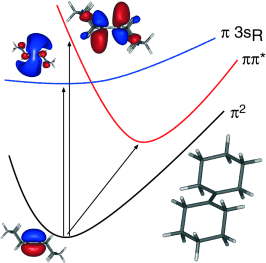Publications
Scroll down for articles in descending order of publication date.
For a full list, please check Google Scholar.
Scroll down for articles in descending order of publication date.
For a full list, please check Google Scholar.
ChemPhysChem (2008)

The electronic excited states of the olefin 1,1′‐bicylohexylidene (BCH) are investigated using multiconfigurational complete active space self‐consistent‐field second order perturbation theory in its multi‐state version (MS‐CASPT2). Our calculations undoubtedly show that the bulk of the intensity of the two unusually intense bands of the UV absorption of BCH measured with maxima at 5.95 eV and 6.82 eV in the vapor phase are due to a single ππ* valence excitation. Sharp peaks reported in the vicinity of the low‐energy feature in the gas phase correspond to the beginning of the π3sR Rydberg series. By locating the origin of the ππ* band at 5.63 eV, the intensity and broadening of the observed bands and their presence in solid phase is explained as the vibrational structure of the valence ππ* transition, which underlies the Rydberg manifold as a quasi‐continuum.
The Journal of Physical Chemistry B (2008)

The UV−vis absorption spectra of the photoreceptor chromophores biliverdin (BV) in the ZZZssa conformation and the phycocyanobilin (PCB) with conformations ZZZssa and ZZZasa have been investigated by means of time-dependent density functional theory (TD-DFT) with a polarized continuum model. The three systems are studied in different conditions to include protonation, solvation- and protein-environmental effects on gas phase and available X-ray structures. The crystal structures of BV in bacteriophytochrome of Deinococcus radiodurans and PCB in C-Phycocyanin serve to calibrate the performance of the TD-DFT method and allow estimating the spectral shifts created when gas phase structures instead of a proper environment are used. In contrast, the structure of PCB in the cyanobacterial phytochrome Cph1 is unknown. The excellent agreement of the theoretical spectrum with experimentally recorded data for the PCB in the cyanobacterial phytochrome Cph1 strongly supports a semicyclic ZZZssa structure, similar to that found for the BV chromophore.
Zeitschrift für Physikalische Chemie (2008)
We present hydrogen bonds with toroidal densities of the protons, called toroidal hydrogen bonds, in systems with cylindrical symmetry e.g. triatomic molecules AHB or ions AHB+ or AHB–. These may be prepared by excitation of the degenerate bending vibrations and related pseudorotation such that the hydrogen atom (or the corresponding proton) is no longer located on the symmetry axis between atoms A and B, but – classically speaking – it rotates around that axis. Quantum mechanically, the toroidal hydrogen bond is represented by an excited nuclear eigenstate with nuclear wavefunction and corresponding nuclear density which have toroidal shapes around the central nodal line which conincides with the AB symmetry axis. The properties of these bonds are analyzed, including the pseudorotational angular momentum. Toroidal hydrogen bonds may be excited by means of circularly polarized infrared (IR) laser pulses. The results are demonstrated exemplarily for the oriented model system FHF–, by means of combined quantum chemistry calculations of the potential energy and dipole surfaces (adapted from L. González, G. Pérez-Hernández, J. González-Vázquez, (2008), submitted), calculations of the vibrational and pseudorotational states in the frame of Watson’s isomorphic Hamiltonian for linear molecules (J. K. G. Watson, Mol. Phys. 19 (1970) 465), and quantum dynamics simulations of the laser driven nuclear dynamics, analogous to recent applications to CdH2 (I. Barth, J. Manz, P. Sebald, Chem. Phys. 346 (2008) 89).
AIP Conference Proceedings (2007)
Control of time‐dependent wavepackets in the frame of unimolecular reactions is described. The shown applications include photodissociation and photoisomerization dynamics in three isolated systems.